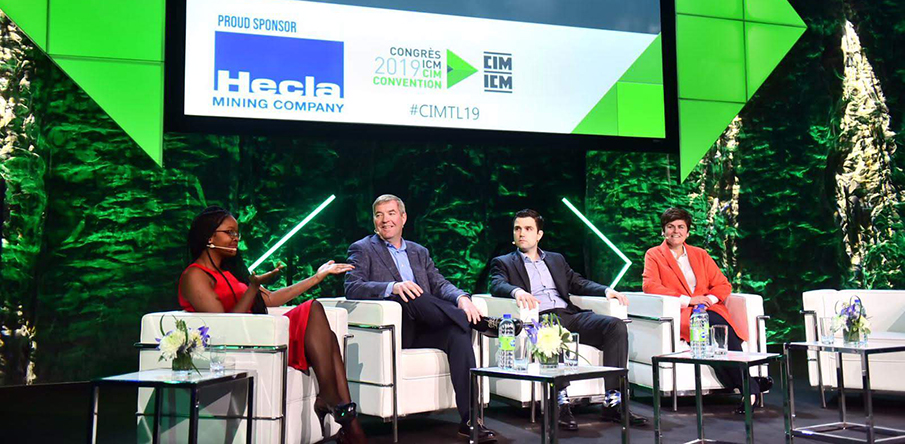29 April 2019
To kick off the second day of the CIM Convention 2019, crowds packed into the ballroom to take part in the Opening Plenary, which focused on “The Changing Face of Mining.” The panelists – Atlantic Gold president and COO Maryse Belanger, Newtrax president and CEO Alexandre Cervinka, Torex Gold president and CEO Fred Stanford, Vale Ontario senior mining engineer Theresa Nyabeze – and Sherritt vice-president of technology Nathan Stubina, who acted as moderator, explored two different faces of the mining industry: the diversity of those working in mining and the public perception of mining.
Click here to watch the webcast of the plenary.
For the first time at the plenary, the audience was able to directly participate in the discussion on stage by voting in poll questions. For instance, the crowd at the CIM Convention, as well as those watching online, rated the mining industry as a “four out of ten” in terms of innovation, but they also described the industry as “essential,” “exciting” and “misunderstood.”
Speaking on the lack of diversity in mining, Nyabeze stated that if she could change one thing about the industry, it would be to teach people that mining can be a place to pursue a career.
“Because we have such high paying jobs underground, I would like to see a lot more women entering the industry, staying there, working and thriving,” Nyabeze said. “I would like to see – in this future that we would create – [a place] where people understand that underground is an environment that is safe, sustainable to work in and an environment where they can actually thrive and really grow their careers... I would change a lot of mindsets that are out there that question the suitability of the mining environment for women.”
On the perceived lack of innovation in the mining sector, Cervinka, Belanger and Stanford all had different views on where innovation could be focused to help improve the industry and its image to the rest of the world.
“Obviously we're big proponents of AI, machine learning and operation research to improve the mine plan. However, we believe that the first stepping stone of what will be a disruptive change in the efficiency of these processes is digitalization,” said Cervinka when asked which technological innovation will be most important to the mining industry. “Without transparency in the process, if you're not measuring all parts of the process, you can't yet apply a lot of that stuff. We're a few years away from being able to apply AI in a big way.You've got to walk before you can run.”
“I think we have a long way to go with education and telling people what we do, explaining things better and developing better partnerships with the communities where we work. The image that people have [about mining] is as it relates to all the mining in the 1950s, for example,” Belanger said. “And today fatalities, accidents, tailings dam failures do not help. At the same time, that image has to be about doing good while we mine, I really believe that. It's really simple in a way, but it's about making a difference in people's life.”
“There's a whole lot of things about the way we mine that could benefit from just looking at the process and saying let's not do it that way; let's completely change the process before we automate,” Stanford said. “So we've gone through the process right from the refinery and looked at every single process where there's storage, transport or transformation and asked, 'Why do we do that? Can we not do it? And if we did something different earlier in the process, could we eliminate it or at least make it more efficient?’”
Before saying goodbye to the panelists, Stubina left the crowd with a useful proverb: “The best time to plant a tree was 20 years ago, the second best time is now.” He encouraged those in attendance not to forgo the past, but to look forward to the future as the face of mining changes.
 - dev.png)


